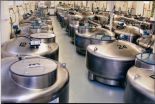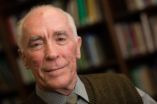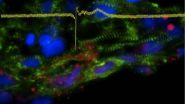(Press-News.org) COLUMBUS, Ohio – Research has suggested that compounds that give colorful fruits their rich hues, especially berries, promote health and might even prevent cancer. But for the first time, scientists have exposed extracts from numerous berries high in those pigments to human saliva to see just what kinds of health-promoting substances are likely to survive and be produced in the mouth.
It's too early to name the best berry for health promotion based on this initial work. But the researchers have discovered that two families of pigments that provide berries with their colors, called anthocyanins, are more susceptible to degradation in the mouth than are the other four classes of these pigments.
The Ohio State University study also showed that bacteria living in the mouth are responsible for most of the breakdown of these compounds that occurs in saliva. Researchers are investigating whether it's the berry pigments themselves, or instead the products of their degradation, that actually promote health.
Scientist say that these early findings will contribute to the further development of confectionaries, gums and other delivery devices for the prevention and possibly the treatment of conditions such as periodontal disease and oral cancers.
The researchers exposed extracts of anthocyanin pigments from blueberries, chokeberries, black raspberries, red grapes and strawberries to the saliva collected from 14 people. Black raspberries, in particular, have been shown in numerous previous studies to have chemopreventive effects on tumors in the mouth, esophagus and colon, mostly in animal studies. Their high anthocyanin content has been linked to those benefits.
"All fruits are unique because their chemical composition, or fingerprint, varies," said Mark Failla, professor of human nutrition at Ohio State and interim chair of the Department of Human Sciences. "There are many different edible berries. Some might be better for providing health-promoting effects within the oral cavity, whereas others may be more beneficial for colonic health. We simply do not know at this time.
"Increased intake of fruits and vegetables is associated with decreased risk of some chronic diseases. An understanding of the metabolism of these compounds, and the relative activities of the compounds in the consumed fruit and their metabolic products, is needed to make scientifically sound dietary recommendations and to develop effective delivery vehicles for the mouth," Failla said.
The research is published in a recent issue of the journal Food Chemistry.
Failla and colleagues asked 14 healthy individuals between the ages of 21 and 55 years to collect saliva in the morning before they had eaten breakfast or brushed their teeth. Research participants later collected additional saliva samples before and after they had rinsed their mouths with an antibacterial liquid.
The five fruits selected for study allowed the scientists to test the six distinct families of the anthocyanin pigments. Researchers purified the anthocyanins from each berry type and added the extracts to saliva.
The extent of the pigment degradation in saliva was primarily a function of the chemical structure of a given anthocyanin, said Failla, also an investigator in Ohio State's Comprehensive Cancer Center and Food Innovation Center.
Two families of anthocyanins consistently degraded when exposed to saliva: delphinidin and petunidin. Four other families were more stable: cyanidin, pelargonidin, peonidin and malvidin.
"Our observations suggest that the bacteria within one's oral cavity are a primary mediator of pigment metabolism. The bacteria are converting compounds that are present in the foods into metabolites," Failla said. "One area of great interest is whether the health-promoting benefits associated with eating anthocyanin-rich fruits like berries are provided by the pigment itself, the natural combinations of the pigments in the fruit, or the metabolites produced by bacteria in the mouth and other regions of the gastrointestinal tract."
There is context for this study that further complicates the understanding of anthocyanins' benefits. Multiple studies have led to the conclusion that anthocyanins themselves are very poorly absorbed by the body.
"If anthocyanins are the actual health-promoting compound, you would want to design food products, confectionaries and gels containing mixtures of anthocyanins that are stable in the mouth. If, on the other hand, the metabolites produced by the metabolism of anthocyanins are the actual health-promoting compounds, there will be greater interest in fruits that contain anthocyanins that are less stable in the oral cavity," Failla said. "We lack such insights at this time."
The extent to which the anthocyanins were degraded varied among the 14 people whose saliva was used in the study. However, two families of anthocyanins consistently degraded the most in all volunteers. Failla said the observed variation among individuals is likely related to differences in the microbial community that resides in each person's mouth.
This research group is continuing the work, examining which bacteria are most involved in the metabolism of anthocyanins and testing the stability of the pigments in berry juices in the mouths of human volunteers rather than in test tubes containing their saliva.
###
This work was supported in part by the Ohio Agricultural Research and Development Center.
Co-authors include Kom Kamonpatana of the Interdisciplinary Ph.D. Program in Nutrition; Monica Giusti and Ken Riedl of the Department of Food Science and Technology; Chureeporn Chitchumroonchokchai of the Department of Human Nutrition; and Maria MorenoCruz and Purnima Kumar of the Department of Periodontology, all at Ohio State. All but MorenoCruz are also investigators in the Food Innovation Center.
Contact:
Mark Failla
Written by Emily Caldwell
614-292-8310
Caldwell.151@osu.edu
Some health benefits of berries may not make it past your mouth
2013-01-28
ELSE PRESS RELEASES FROM THIS DATE:
Soya protein can be replaced by rapeseed protein
2013-01-28
Jena (Germany) Today, more than 500 million people are suffering from a lack of adequate protein in their diet. Each year, the number of human beings increases by 80 million, a figure which is equivalent to the present population of Germany. Thus, providing enough food, particularly sufficient protein for the increasing populace is a challenging task for societies all over the world. On a prospective basis, a progressively smaller proportion of human protein requirement can be provided by animal proteins such as meat, eggs, and milk. "However, by feeding valuable plant ...
Study of human specimen collections in the US offers first look at their huge diversity
2013-01-28
Chapel Hill, N.C. – Biobanks are organizations that collect, store and share human specimens (e.g., blood, solid tissues, hair) for research purposes. The rise of the human genome project and of large-scale genetics studies have spurred a dramatic increase in the number of biobanks in the last decade, increasing their importance in biomedical research.
But until now, biobanks in the U.S. have never been studied systematically, leaving few clear details as to how they are run or the policies and practices they use in managing their work.
A new study from the University ...
Discovering the missing 'LINC' to deafness
2013-01-28
Tel Aviv — Because half of all instances of hearing loss are linked to genetic mutations, advanced gene research is an invaluable tool for uncovering causes of deafness — and one of the biggest hopes for the development of new therapies. Now Prof. Karen Avraham of the Sackler Faculty of Medicine at Tel Aviv University has discovered a significant mutation in a LINC family protein — part of the cells of the inner ear — that could lead to new treatments for hearing disorders.
Her team of researchers, including Dr. Henning Horn and Profs. Colin Stewart and Brian Burke of ...
With hot air treatment, bacteria fly the coop
2013-01-28
This press release is available in Spanish.Poultry producers can reduce bacterial cross-contamination in poultry cages by treating the cages with forced air that's been heated to 122 degrees Fahrenheit, according to a study by U.S. Department of Agriculture (USDA) scientists.
While being transported in coops on trucks, poultry that have bacteria such as Campylobacter can contaminate, through their feces, other poultry that are free of pathogens. Those disease-causing bacteria can then be passed on to the next group of birds during the next trip, and so forth, unless ...
Islet transplant may slow progression of atherosclerosis
2013-01-28
Minimally invasive islet transplantation for patients with type 1 diabetes achieves insulin independence and reverses the progression of atherosclerosis in the first few years after transplant, according to a University of Illinois at Chicago study.
The research is published in the February issue of the journal Diabetes Care and is available online.
Patients with diabetes, particularly women, have a substantial increased risk of dying from ischemic heart disease, according to previous research. However, future cardiac events may be prevented with intensive glycemic ...
Central Valley irrigation intensifies rainfall, storms across the Southwest
2013-01-28
Irvine, Calif., Jan. 28, 2013 – Agricultural irrigation in California's Central Valley doubles the amount of water vapor pumped into the atmosphere, ratcheting up rainfall and powerful monsoons across the interior Southwest, according to a new study by UC Irvine scientists.
Moisture on the vast farm fields evaporates, is blown over the Sierra Nevada and dumps 15 percent more than average summer rain in numerous other states. Runoff to the Colorado River increases by 28 percent, and the Four Corners region experiences a 56 percent boost in runoff. While the additional ...
Safeguards needed for tissue donors
2013-01-28
Donors to biobanks – vast collections of human tissue samples that scientists hope will lead to new treatments for diseases – have a right to basic information about how their donations may be used, a Michigan State University ethicist argues in a new paper.
The idea behind biobanks is that a repository with hundreds of thousands of samples, each linked to medical records and other health information, can yield discoveries smaller data sets can't match. Once samples are collected, researchers in many fields can use the data repeatedly.
"More and larger biobanks are ...
New LGBT Health journal launching in 2013
2013-01-28
New Rochelle, NY, January 28, 2013—Over 4 million adults in the United States identify as gay, lesbian, or bisexual and approximately 700,000 identify as transgender. An NIH-sponsored investigation by the Institute of Medicine (IOM) concluded that the health status and healthcare needs of this sizable population are poorly understood and likely inadequately met. A journal is urgently needed to support, promote, and address the unique healthcare needs of each population that comprises the LGBT community, in the United States and worldwide. LGBT Health, a new peer-reviewed ...
Best friends influence when teenagers have first drink
2013-01-28
Chances are the only thing you remember about your first swig of alcohol is how bad the stuff tasted. What you didn't know is the person who gave you that first drink and when you had it says a lot about your predisposition to imbibe later in life.
A national study by a University of Iowa-led team has found that adolescents who get their first drink from a friend are more likely to drink sooner in life, which past studies show makes them more prone to abusing alcohol when they get older. The finding is designed to help specialists predict when adolescents are likely to ...
Patients' own skin cells are transformed into heart cells to create 'disease in a dish'
2013-01-28
LA JOLLA, Calif., January 27, 2013 – Most patients with an inherited heart condition known as arrhythmogenic right ventricular dysplasia/cardiomyopathy (ARVD/C) don't know they have a problem until they're in their early 20s. The lack of symptoms at younger ages makes it very difficult for researchers to study how ARVD/C evolves or to develop treatments. A new stem cell-based technology created by 2012 Nobel Prize winner Shinya Yamanaka, M.D., Ph.D., helps solve this problem. With this technology, researchers can generate heart muscle cells from a patient's own skin cells. ...




